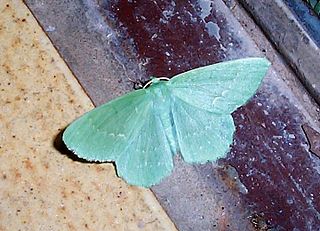
The large emerald is a moth which is the type species for the family Geometridae. It is found throughout the Palearctic region and the Near East. The species was first described by Carl Linnaeus in his 1758 10th edition of Systema Naturae.
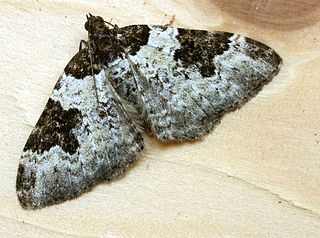
The garden carpet is a moth of the family Geometridae. It is an abundant and familiar species across its huge range which covers the whole Palearctic region from Ireland to Japan and including the Near East and North Africa. It was first described by Carl Linnaeus in his 1758 10th edition of Systema Naturae.
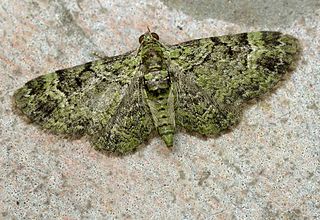
The green pug is a moth of the family Geometridae. It is sometimes placed in the genus Chloroclystis or Rhinoprora. It is common throughout the Palearctic region and the Near East.

The brimstone moth is a moth of the family Geometridae. The species was first described by Carl Linnaeus in his 1758 10th edition of Systema Naturae.

The grass emerald is a species of moth. It occurs throughout central and south-eastern Europe and in Asia Minor and the Caucasus further east to the Urals and Siberia. It is fairly common throughout Great Britain with the exception of northern Scotland. In the southern Alps, it rises up to 1500 metres. The species was first described by Johann Siegfried Hufnagel in 1767.

Geometrinae is the nominate subfamily of the geometer moth family (Geometridae). It is strongly split, containing a considerable number of tribes of which most are presently very small or monotypic. These small moths are often a light bluish green, leading to the common name of emerald moths, though a few species called thus are also found in the tribe Campaeini of the Ennominae. A phylogeny and classification was published in the Zoological Journal of the Linnean Society in which 13 tribes were accepted.
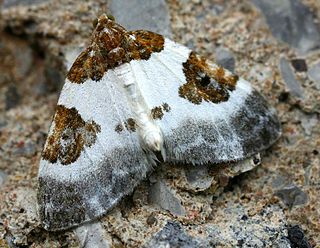
The Cidariini are the largest tribe of geometer moths in the subfamily Larentiinae. The Cidariini include many of the species known as "carpets" or, ambiguously, "carpet moths", and are among the few geometer moths that have been subject to fairly comprehensive cladistic study of their phylogeny. The tribe was described by Philogène Auguste Joseph Duponchel in 1845.

Hylaea fasciaria, the barred red, is a moth of the family Geometridae. The species can be found in Central and North Europe, Urals, Caucasus, Altai and East Siberia.

Pelurga comitata, the dark spinach, is a moth of the family Geometridae. It is found throughout the Palearctic, including Europe, Siberia, the Russian Far East and northern China

Aeolochroma is a genus of moths in the family Geometridae described by Prout in 1912.
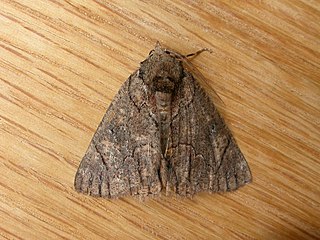
Heliomystis is a monotypic moth genus in the family Geometridae. Its only species, Heliomystis electrica, the electric moth, is found in the southern half of Australia. Both the genus and species were first described by Edward Meyrick in 1888.
Lophothorax is a monotypic moth genus in the family Geometridae. It consists of only one species, Lophothorax eremnopis, which is found in Australia. Both the genus and the species were first described by Alfred Jefferis Turner, the species in 1922 and the genus in 1939.
Orthorisma is a genus of moths in the family Geometridae described by Prout in 1912. It consists of only one species, Orthorisma netunaria, first described by Achille Guenée in 1858. It is found in Brunei, Malaysia and Indonesia.
Pachista is a genus of moths in the family Geometridae described by Prout in 1912. It consists of only one species, Pachista superans, first described by Arthur Gardiner Butler in 1878, which is found in China, Japan and Korea.
Pullichroma is a monotypic moth genus in the family Geometridae erected by Jeremy Daniel Holloway in 1996. Its only species, Pullichroma pullicosta, was first described by Louis Beethoven Prout in 1931. It is found in Brunei, Indonesia and the Philippines.
Sundadoxa is a monotypic moth genus in the family Geometridae erected by Jeremy Daniel Holloway in 1996. Its only species, Sundadoxa multidentata, was first described by Louis Beethoven Prout in 1916. It is found in Brunei, Sumatra in Indonesia, Sarawak and Peninsular Malaysia.

Philereme transversata, the dark umber, is a moth of the family Geometridae. It is found in much of the Palearctic ecozone.
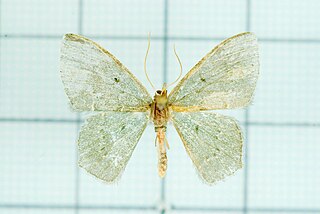
Hemithea aquamarina is a moth of the family Geometridae first described by George Hampson in 1895. It is found in the north-eastern parts of the Himalayas, Taiwan and Borneo.
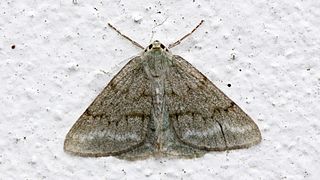
The Pseudoterpnini are a tribe of geometer moths in the subfamily Geometrinae. The tribe was described by Warren in 1893. It was alternatively treated as subtribe Pseudoterpniti by Jeremy Daniel Holloway in 1996.

Pingasa angulifera is a moth of the family Geometridae first described by William Warren in 1896. It is found in Queensland, Australia.














